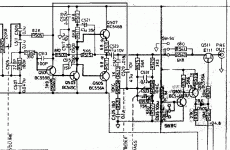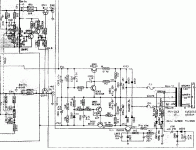Hi GG,
You should completely remove those transistors if you want to bypass them or use another muting method. It appears the signal passes through those fets from past experience with NAD. I would replace them with a signal relay. High value resistors to ground on both sides to reduce any "pop". Or, a high value resistance across the contacts and another to ground for attenuation while in mute mode. Depends on what the circuit is like.
-Chris
You should completely remove those transistors if you want to bypass them or use another muting method. It appears the signal passes through those fets from past experience with NAD. I would replace them with a signal relay. High value resistors to ground on both sides to reduce any "pop". Or, a high value resistance across the contacts and another to ground for attenuation while in mute mode. Depends on what the circuit is like.
-Chris
GG said:have to take that back. Most of the line amp section is similar.
There are at least 3 or 4 different revs of the 3020 on top of all that. The man i got was before any muting circuitry was added.
dave
Hi planet10,
Thanks! Can you post the power supply as well please?
GG,
We can see the mute is triggered by contacts on the power switch. Q509 and 510 control the gates of the fets. Check the switch contacts are working first, short and open yourself and watch the voltages on the "G" terminals.
-Chris
Thanks! Can you post the power supply as well please?
GG,
We can see the mute is triggered by contacts on the power switch. Q509 and 510 control the gates of the fets. Check the switch contacts are working first, short and open yourself and watch the voltages on the "G" terminals.
-Chris
anatech said:Can you post the power supply as well please?
Attachments
I plan to remove the transistors and run the signal to the balance controls. Unfortunately, I will have to let this sit for a few weeks until I get time to work on it. I will post the results.
Then I would like to upgrade capacitors and possible try a conductive plastic pot.
Thanks for all your help.
Also, thank you Dave for the plans.
Then I would like to upgrade capacitors and possible try a conductive plastic pot.
Thanks for all your help.
Also, thank you Dave for the plans.
anatech said:Hi GG,
You should completely remove those transistors if you want to bypass them or use another muting method. It appears the signal passes through those fets from past experience with NAD. I would replace them with a signal relay. High value resistors to ground on both sides to reduce any "pop". Or, a high value resistance across the contacts and another to ground for attenuation while in mute mode. Depends on what the circuit is like.
-Chris
And then there was music
Back from the northern Canadian Shield and after a nice BBQ steak dinner (and wine) I sat down with the pre-amp again. I could not track down the problem with the gate voltage so I simply removed the muting transistors and conected the source and drain on the PCB and there it was .. sweet music once again. There is -10V where the gates were, but I don't see that as a problem.
Seeing that I have the case open and given the price of fuel, I may poke around this weekend and upgrade some capacitors.
Thank you Chris and Dave for all your help.
Back from the northern Canadian Shield and after a nice BBQ steak dinner (and wine) I sat down with the pre-amp again. I could not track down the problem with the gate voltage so I simply removed the muting transistors and conected the source and drain on the PCB and there it was .. sweet music once again. There is -10V where the gates were, but I don't see that as a problem.
Seeing that I have the case open and given the price of fuel, I may poke around this weekend and upgrade some capacitors.
Thank you Chris and Dave for all your help.
anatech said:So you went up to feed the bugs. Wonderful up there (except for the bugs).
-Chris
Feed them I did...they seem to like Italian blood. Those black flies are nasty. I cannot understand how something that you cannot feel when it bites can cause your head to bleed. I am still picking scabs out of my scalp. Fortunately, is was too cold for bulldogs (horse flies).
I get a pop when I power on or switch between sources. I'm not sure if the muting circuit would help when switching between sources? This is not a problem right now as I use the preamp with low power tube gear. I guess I will have to be carefull with a high power amp.
With regards to upgrading capacitors in the signal path, what options do I have to upgrade 4.7uF and 47uF capacitors (25V max)? Poly caps for those values will be expensive and very large in size making it difficult to fit on the board. Would adding some small poly caps in parallel help much?
Hi GG,
The muting circuit will help the turn on and off thumps. Switching noise - maybe. The intention is to replace the muting circuit, right?
Hey, Italian blood is full of the good stuff! Garlic, tomatoes, MEAT, on and on. I had an Italian girlfriend once. Really nice person and knew how to cook!!! Apparently the bugs can tell eh?
-Chris
The muting circuit will help the turn on and off thumps. Switching noise - maybe. The intention is to replace the muting circuit, right?
Hey, Italian blood is full of the good stuff! Garlic, tomatoes, MEAT, on and on. I had an Italian girlfriend once. Really nice person and knew how to cook!!! Apparently the bugs can tell eh?
-Chris
GG said:With regards to upgrading capacitors in the signal path, what options do I have to upgrade 4.7uF and 47uF capacitors (25V max)? Poly caps for those values will be expensive and very large in size making it difficult to fit on the board. Would adding some small poly caps in parallel help much?
I cooresponded extensively with a fellow who replaced almost every cap (and a lot of Rs) in his 7020. he used mostly blackgates. The results were reportedly stunning. Swapping critical coupling caps with poly is a good idea thou.
dave
Not to be a kill joy, and I don't intend to be, replacing a couple critical caps can bring an improvement. But the replacement part has to fit in the original space.
I've been called on to repair many swap'em out jobs. Many write-offs and lots of foil damage.
Keep in mind that new electrolytics are much better than the older ones, and there are other limitations to deal with. Unbiased electrolytics are still a bad deal though.
-Chris
I've been called on to repair many swap'em out jobs. Many write-offs and lots of foil damage.
Keep in mind that new electrolytics are much better than the older ones, and there are other limitations to deal with. Unbiased electrolytics are still a bad deal though.
-Chris
anatech said:Not to be a kill joy, and I don't intend to be, replacing a couple critical caps can bring an improvement. But the replacement part has to fit in the original space.
I've been called on to repair many swap'em out jobs. Many write-offs and lots of foil damage.
Keep in mind that new electrolytics are much better than the older ones, and there are other limitations to deal with. Unbiased electrolytics are still a bad deal though.
-Chris
Yup, getting poly caps to fit will be a problem. There are two (per channel) 4.7uF in the signal path of the phono and one 47uF in the linestage. I don't have anything suitable on hand, so I will put this off for the time being until I make an order for some other parts. I will likely try blackgates as several people speak so fondly of them.
All the pots are scratchy so I will try some contact cleaner on them. Does upgrading to a blue velvet seem like money well spent?
Considering the age of this unit, I think it sounds very good. The phono stage is esspecially nice.
Hi GG,
Why not replace them with new electrolytics now. Then bypass them with about 1 uF Poly - whatevers and see if there is a positive difference. Bypass the supply caps while you are in there. 100uF to 470uF and some films. This may make the biggest difference.
Use either De-Ox-Id from GC (I think - Active may stock it) or Caig DeoxIT DP5. Either will work extremely well. You only need a small amount on the metal wiper, not the carbon track. Always use only as much needed to do the job.
-Chris
Why not replace them with new electrolytics now. Then bypass them with about 1 uF Poly - whatevers and see if there is a positive difference. Bypass the supply caps while you are in there. 100uF to 470uF and some films. This may make the biggest difference.
Use either De-Ox-Id from GC (I think - Active may stock it) or Caig DeoxIT DP5. Either will work extremely well. You only need a small amount on the metal wiper, not the carbon track. Always use only as much needed to do the job.
-Chris
anatech said:Bypass the supply caps while you are in there. 100uF to 470uF and some films. This may make the biggest difference.
Reminds me of a local who swapped in a bigger power trafo with reported improvements.
dave
anatech said:Hi GG,
Why not replace them with new electrolytics now. Then bypass them with about 1 uF Poly - whatevers and see if there is a positive difference. Bypass the supply caps while you are in there. 100uF to 470uF and some films. This may make the biggest difference.
-Chris
planet10 said:Also note that ir seems the values in the regulator are fairly critical. The fellow with the 7020 tired larger caps & went back to the stock size.
dave
The supply caps are small, only 330uF on each rail. Like Dave mentioned, I have read of others having problems with larger caps on the supply. I am thinking of a nice cap (pannasonic) same size with a small 1uF poly bypass. I don't have capacitors on hand right now, so if I have to order, I may as well go with blackgates or pannasonics.
I had Nad 3020i and a lot more expensive gear, my expirience is that paraleling elcos with bipolars in signal path always means worse results. Like to diferent caps trayng to fight with eachother. I have best sound in Nad integrated amps and preamps with Blackgate nonpolars (47uF/16V) in input positions.
All the best!
All the best!
- Status
- This old topic is closed. If you want to reopen this topic, contact a moderator using the "Report Post" button.
- Home
- Amplifiers
- Solid State
- NAD 1020 Preamp Problems

